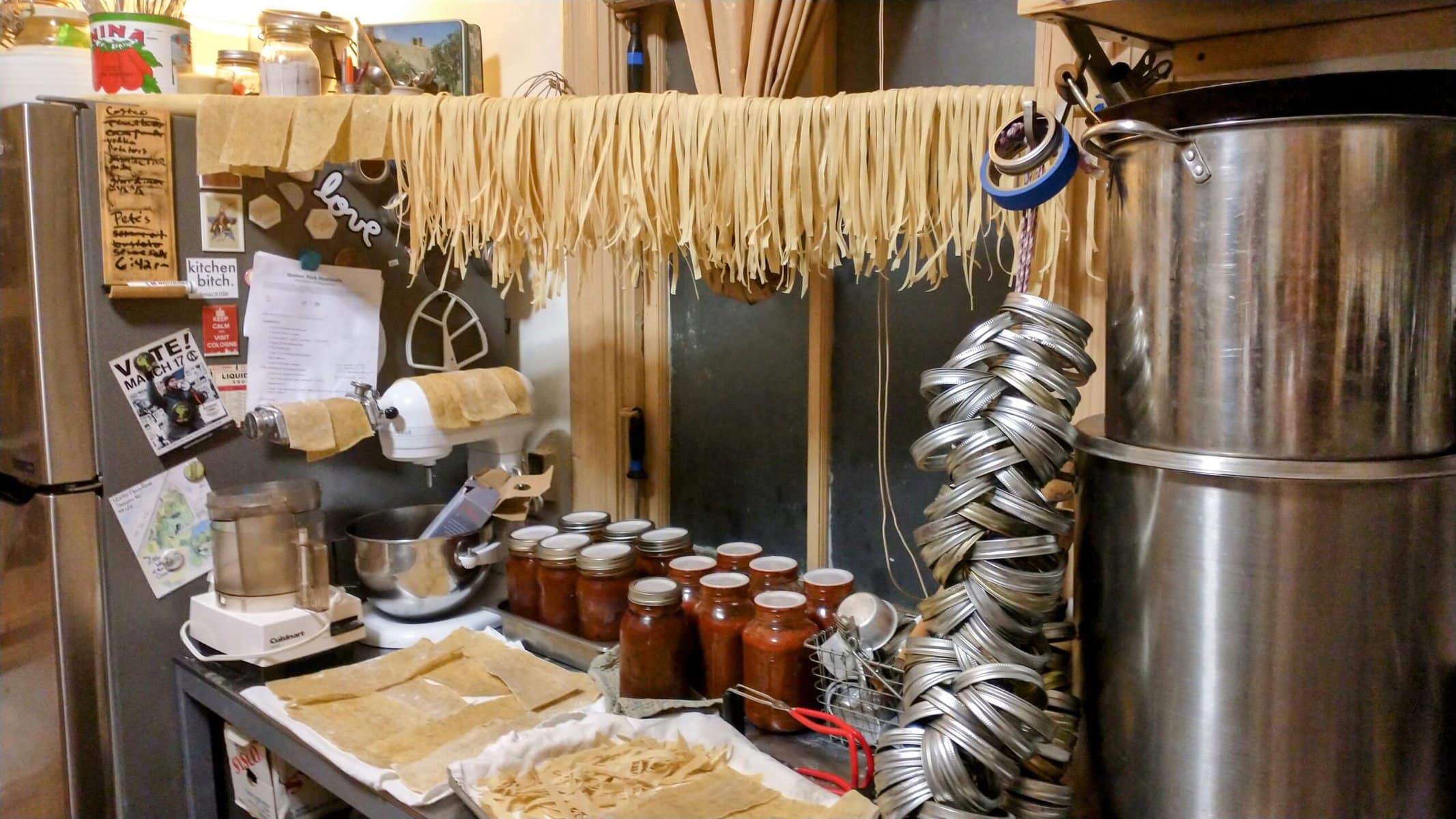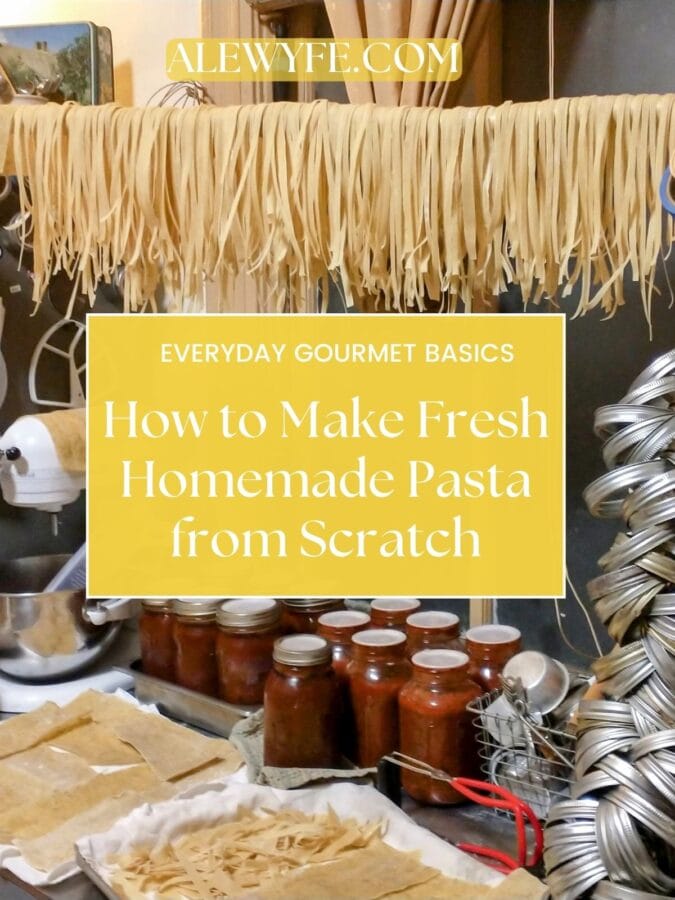COOK: How to Make Fresh Pasta from Scratch
Once you learn how to make fresh pasta, you can be your own Pasta Granny, even if you aren’t Italian (or a granny). It might sound intimidating, but you can make fresh egg noodles with very simple ingredients and almost no special equipment right in your own kitchen.
Fresh Homemade Pasta with Simple Pantry Ingredients
Flour, egg, maybe a pinch of salt, and that’s it. You can play around with specialty flours, but you can make a very delicious egg noodle with just regular old white all-purpose flour from your pantry. I like to add a bit of semolina flour if I have it, which makes a springier, chewy noodle, but you can get by just fine with what you probably already have in your cupboard.
No Expensive Specialty Equipment Needed!
All you really need to make fresh pasta is a clean flat surface (a smooth counter or sturdy table, or even a large cutting board) and a rolling pin.
Sure, it’s easier if you have a food processor and a pasta machine, but people made homemade noodles for thousands of years before KitchenAid or even hand-cranked Atlas pasta rollers came along, and I taught myself how to do it a couple decades ago, using just a plain French rolling pin and a couple cookbooks… it does take some elbow grease to roll and stretch the sheets of dough by hand, and now I’m grateful for the mechanical advantage of using a roller attachment for my mixer (as are my wrists, though the workout you get doing it all by hand is a nice appetite-builder).
But don’t think you have to spend a lot of money to try this out! I hang my pasta to dry on a bamboo pole propped up between a kitchen shelf and the fridge (you can use a clean broomstick or dowel rod, or even the back of a chair covered with a flour-sack towel, or of course an actual pasta drying rack). I have an inexpensive generic dough roller attachment for my mixer which speeds everything up enough that this can be a weeknight meal.
I mix my pasta dough in a vintage Cuisinart food processor that I found at Goodwill for less than $10 (in the original packaging… it was old but it works great and am not sure it was ever used), but you can use any sturdy food processor or even a heavy-duty stand mixer if you don’t want to mix your dough by hand.
That said, I mixed and rolled my pasta dough out by hand for a long time before deciding to spend the extra money on a dough roller attachment!
And while I’d love an Atlas pasta maker with cutter attachments like the ones we used in culinary school (but not quite enough to buy one right now… especially the swoon-worth light blue one here… though the sensible stainless ones work just as well and are a little less), it’s not hard and a good workout to roll out and hand cut the noodles.
I have a small Italian roller-cutter hand-tool that makes quick work of cutting fettuccine, though it’s often easier to just let the sheets of pasta dry enough that they don’t stick, roll them loosely, and cut the noodles with a knife.
If you get really into homemade pasta though, there are all sorts of fun tools you can collect- gnocchi boards and other grooved or patterned surfaces for rolling or cutting the dough, wire chitarra cutters, sets of little dowel rods both grooved and smooth for shaping specialty noodles… but really, you just need a cutting board or clean flat countertop, a rolling pin, and a knife or pizza cutter, and you can make fresh pasta at home today!

Fresh Homemade Pasta
Ingredients
- 3½ cups all purpose flour
- ½ cup semolina can sub ½ cup all purpose flour
- ½ tsp salt
- 4 large eggs
Instructions
- In a medium mixing bowl or food processor, combine the all purpose flour, semolina flour, and salt and stir or pulse a few times to mix. If you are working by hand, make a well in the center of the dry ingredients in a large bowl or on a clean, flat work surface.
- Add the eggs to the food processor and pulse a few times just until combined. The dough will look dry and crumbly but if you squeeze it, it should come together and feel supple but not too tacky. If you are working by hand, use a fork to blend the eggs together in the center of the "volcano" and then gradually incorporate the flour from around the edges until you have a stiff dough.
- Turn the dough out onto a lightly floured surface and knead until smooth and elastic- it should be soft but springy, like an earlobe. If it is too dry, you can work in some water, no more than a tsp at a time, and if it's too wet, knead in more flour. The coarser semolina flour will hydrate and absorb moisture from the dough as it rests, so you can make it a little stickier than regular pasta dough, but it shouldn't stick to floured hands.
- When you are satisfied with the consistency, wrap the dough tightly and let rest. You can make it a day or two ahead- wrap well and chill in the fridge. The outside of the dough may discolor slightly but it will be fine to use.
- Cut the dough into quarters and roll out each quarter into thin sheets (0 or 1 on a pasta machine). Hang the sheets on a pasta drying rack, dowel rod, or lay them out on clean flour sack towels on a work surface or table.
- Working with the first sheet, cut into ¼"-1" wide noodles using a pizza or pasta cutter, sharp knife, or bench scraper. If the pasta sheets are dry enough to not stick together, you can roll the sheets and cut sections to get even noodles, or cut the whole sheet flat. Hang to dry slightly or lay out in bundles on towels or sheet pans.
- Cook fresh pasta immediately in a large pot of salted boiling water, or refrigerate for up to three days or freeze for up to six months. You can also carefully dry the egg noodles and store them in tins the traditional way, but this is risky as they contain raw egg and may mold or spoil. It's best to use them fresh or freeze them for later use.
- Fresh pasta cooks much faster than dried or store-bought "fresh" pasta... just a few minutes. Time will vary with the thickness of the noodle, but the pasta will float... test it and drain when it's perfectly al dente. Frozen pasta will take a minute or two longer (more if it's filled than for flat noodles).




